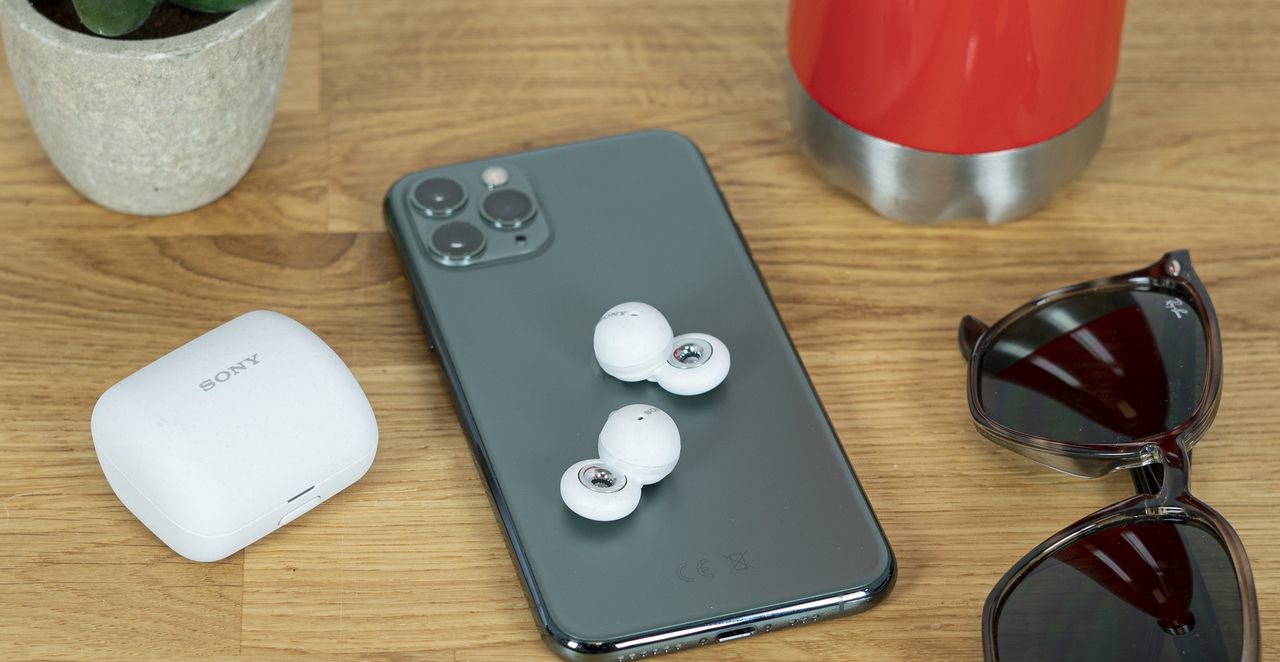Sony LinkBuds WF-L900
With the LinkBuds, Sony introduces a new concept of open true wireless headphones that allow you to remain aware of your surroundings in all circumstances. However, poor sound performance was to be feared with such a design.
Presentation
What a strange pair of headphones from Sony! The LinkBuds inaugurate a brand new true wireless concept with a "perforated" design that is intended to be the least isolating and intrusive possible. They are of course free of an active noise reduction feature, the goal being to remain aware of your environment while listening to music.
The LinkBuds also innovate with the way the controls are done. There's no longer any need to aim your finger at the button or touch surface of the earpiece; just tap on the area between your ear and cheek to trigger an action. Otherwise, these are true wireless headphones that could not be more classic and include many of the features already present on the WF-1000XM4 of the same brand.
Manufacturing & accessories
Next to the imposing designs we are used to from Sony, the LinkBuds look very small with a very discreet and light design (4.1 g per earphone). Each earphone is made up of two parts: the first, spherical, protrudes slightly from the ear and serves as a hook for the silicone stabilizer; the second is doughnut-shaped, with a hole that is supposed to line up with the entrance to the ear canal.
The quality of assembly of the earphones is correct and they seem robust. Their shell is made of plastic with a matte finish and a metal crown on the doughnut-shaped part, adding elegance to the whole. Certified IPX4, the LinkBuds are splash and sweat resistant. However, you'll want to make sure you clean them thoroughly after each sport session to maximize their longevity.
Like the headphones, the case is very small and will not have any trouble fitting into a pants pocket. It's made of the same plastic used for the headphones and feels just as sturdy. The LinkBuds are firmly held inside by magnets and a very efficient "clip" system. The cover is also held closed with a notch, which makes it a little difficult to handle with one hand. However, there is nothing to complain about the hinge, which is strong enough to withstand multiple openings.

Comfort & fit
Because of their light weight and non-intrusive design, LinkBuds are especially comfortable and can be worn during long listening sessions without discomfort. They also have a good support, provided you choose the right size of silicone stabilizers among the five pairs provided. The stabilizers could have been slightly stiffer to increase the support, but this does not prevent the earphones from being quite ready for sports.
While all this praise was true for the majority of people we had try the headphones on, they may not be suitable for all body types. For example, it is possible to feel a pressure point in the concha during prolonged listening sessions. The positioning of LinkBuds is not always easy and it is often necessary to take several times to find the good alignment of the part with the hole with the entry of the auditory canal.
User experience
Beyond their disruptive new design, the LinkBuds are innovative in the way they are interacted with. Sony's earphones have no buttons or touch surfaces and are controlled by vibrations created by tapping the earphone itself, or the area between the cheek and the ear. This new way of interacting with your earphones proved to be quite effective during our test, but it is still less precise and reliable than a dedicated button. Indeed, this method sometimes proved to be capricious by performing unwanted actions or needing to be repeated twice for the action to be triggered. In case this becomes too hazardous, however, it is possible to reduce the vibration sensitivity by disabling the dedicated feature.
The controls can be activated with a series of two or three taps on each side and allow you to start play/pause and move to the next track. In the Headphones Connect app, it is possible to assign these tap sequences to other actions from an exhaustive list: return to the previous track, volume control, activation of the voice assistant or launch the Spotify app. However, the number of available commands is limited to four (two tap combinations on each side), so you have to carefully choose the desired actions.
Beyond this specificity, the LinkBuds are quite classic true wireless headphones. The pairing procedure is triggered by pressing the button on the back of the box for several seconds. You'll need to do this for each new source, as the LinkBuds don't have multipoint functionality. Once connected, the headphones communicate via Bluetooth and are compatible with SBC and AAC codecs.
The LinkBuds also include many of the same gadget features found on the WF-1000XM4, such as Speak to chat and adaptive volume control. They also include presence sensors and switch to mono when one of the earphones is stored in the case.
All of these features, and more, can be configured within the excellent Headphones Connect app. The latter is all the more essential here as no instructions are delivered with the headphones. So you have to go through the tutorial in the app to learn how to use these LinkBuds. In addition to the options mentioned above, we find in this app (among others) an equalizer, information on the codec used or on the remaining battery level.
Battery life
Although devoid of power-hungry features like active noise reduction, the LinkBuds are far from being among the longest-lasting earphones we tested. They still manage to do well with a measured autonomy of 6 h 30 min (AAC codec and volume at 60% of its maximum value), which is one hour more than the 5 h 30 min promise made by Sony. The case offers about two additional charges for a total of about twenty hours.

Hands-free kit
The quality of the microphones of the hands-free kit is sufficient to retranscribe the voice quite intelligibly, although its timbre is altered, even very altered in the least favorable conditions. Obviously, the headphones are most effective in a quiet environment: the voice is a little nasal, but clear and perfectly understandable. We notice however that the noise reduction processing is already at work and applies to the signal a sort of delay/echo which gives the effect of "resonance" and of not very aesthetic distance that we clearly observe on our first example.
As our second recording shows, the naturalness of the user's voice is clearly affected when in a very noisy environment (a crossroads or a busy street). Nevertheless, the noise reduction algorithm manages to extract the latter from the surrounding hubbub. However, it remains complicated to hold a conversation in such conditions without raising your voice or repeating yourself many times.
Latency
The LinkBuds are right in the middle of the pack with a measured latency of 227 ms in Bluetooth communication. This delay results in an uncomfortable sound/picture lag, which is fortunately compensated for in most video-playing applications, allowing viewing in good conditions. Video games, however, are exempt from such preferential treatment and remain difficult to play.
Audio
Equipping these LinkBuds with drivers must have been no small task for Sony. The doughnut shape requires the integration of a ring-shaped speaker, which is, to our knowledge, a first for true wireless headphones. Despite the promises of an audio treatment equivalent to the excellent WF-1000XM4, the LinkBuds are far from making miracles with almost non-existent bass and a general rendering particularly shrill. The rendering is also strongly dependent on the position of the earphones in the ear, which is problematic knowing the relative difficulty to position them perfectly.
The frequency response curve speaks for itself: the sound signature of these LinkBuds presents a very pronounced peak in the midrange with a total collapse of the bass and treble. This results in an unpleasant, garish sound that distorts the timbre of many instruments and makes voices sound much more prominent and nasal than they should. Instruments rich in harmonics, such as saturated guitars, brass instruments or cymbals, are also too much emphasized. This rendering is also particularly tiring in the long run and quickly gives you a headache, because the human ear is very sensitive to the frequency region emphasized by these headphones (2-3 kHz). Moreover, because of their open format, it is not rare to have to seriously increase the volume in animated environments to correctly hear one's music, thus reinforcing this shouting aspect, but also the acoustic leaks for the greatest displeasure of the people in the vicinity.
With such an architecture, the frank withdrawal of the bass was to be feared. Their very "dry" restitution is deprived of any sensation of warmth or roundness: only the attacks of the instruments remain (stroke of the drum on the bass drum, stroke of the pick on the guitars, slap on a bass...). In addition to this consequent folding, the low frequencies do not enjoy an extraordinary precision, which reinforces the difficulty to correctly discern the various sources officiating in this frequency area, even on the simplest mixes.
The treble also suffers from a certain withdrawal from the midrange. They seem softer than usual and lack finesse: some instruments like cymbals, shakers or other bells can sometimes seem muffled. This lack of definition combined with the strong emphasis on the midrange also poses a problem for the identification of sources, which are all clustered on the same plane. The "open" format of the headphones can however give a good impression of sound width.
Conclusion
It will be difficult for these LinkBuds to find their place among the plethora of true wireless models! Of course, their totally "open" format allows you to remain constantly aware of your environment, but this is far too much at the expense of sound performance in this case. If you're going to choose headphones that are not very intrusive and isolating, you might as well go for some of the other "button" headphones, if only to enjoy a decent music listening experience.




